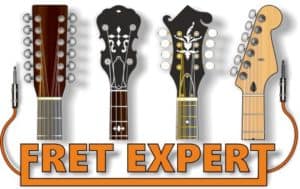After my in-depth review of the Yamaha GL1 Guitalele, I realized some people were asking how the GL1 compares to the Gretsch G9126.
If you’re in the market for a slightly more expensive guitalele, the Gretsch G9126 is definitely a model worth considering.
Visually, this is a much fancier affair than the GL1, but it does come in at over double the price.
The higher outlay is reflected in some interesting features including a solid mahogany top and neck, Grover tuners, bone nut and saddle and some attractive inlay work.
Like the Yamaha, you get a useful gig bag with the package. Sonically, the Gretsch has a nice warm tone, associated with the mahogany construction.
It has plenty of projection and could arguably be suitable for playing some of the classical and Renaissance lute/guitar repertoire if that’s where your interest lies.
One major beef I do have with it is in the string slotting arrangement for the bridge.
I’m not sure why Gretsch decided to go down this route, when most other similar instruments including the Yamaha follow the standard classical guitar convention of threading the strings through tiny holes and winding them back on themselves to secure them in place.
With the Gretsch you either have to buy ball-end nylons or go through the laborious task of knotting the ends yourself – a major hassle if you’re restringing all six! Sorry, Gretsch, a black mark on that one.
Other than that, the G9126 is a very nice instrument, which probably takes it a step or two above the GL1 and a little more suitable for the more experienced player.
For those who like to play live or want to D.I. into a desk and don’t want to go to the trouble of installing a pickup, the G9126 also comes in an electro-acoustic cutaway version (G9126-ACE) with a Fishman Kula pickup.
It also comes with a set of Aquila Nylgut strings as standard, rather than the GL1’s uninspiring unbranded stock strings.
Size-wise there isn’t a lot in it, but for lead pickers, the G9126-ACE with its pickup system and cutaway might be a nice option if you want access to the upper frets.
Opinions on the Gretsch seem to swing wildly between all out praise and heavy criticism of some shoddy workmanship. So it maybe a case of Gretsch not always exercising quality control as rigorously as they should.
For the spec hungry readers out there, I’m including details of the Gretsch spec alongside that of the Yamaha GL1 for further investigation:
Covered in this Article:
Gretsch G9126 vs Yamaha GL1 Specification Comparison
| The Gretsch G9126 | The Yamaha GL1 Guitalele |
| Manufactured: Model Numbers: G9126 / G9126-ACE electro-acoustic Accessories: Gigbag Back & Sides: Mahogany laminateBody Depth: 3.125” / 8cm Body Width: 9.1” / 23cm Bridge: Ovangkol Color: Natural mahogany Cutaway: Yes on the G9126-ACE Fingerboard: Ovangkol Finish: Natural open-pore semi-gloss Frets: 19 Headstock: Slotted with traditional Gretsch logo Inlays: Mother of pearl diamond snowflake design Length: 28.3” / 72cm Neck: Mahogany (1-piece) Neck Width: 1 7/8” / 4.8cm Nut: Bone Nut Width: 1 7/8” / 4.8cm Pickup: Fishman Kula on the G9126-ACE Saddle: Bone Scale Length: 17” / 43.2cm Size: ¼ (in guitar sizing) Strap Buttons: Not included Strings: Aquila Nylgut Top: Solid Mahogany Tuners: Grover Sta-Tite geared tuners (nickel-plated) Tuning: A-D-G-C-E-A | Manufactured: Indonesia Model Numbers: GL1 / GL1 BK / GL1 PB / GL1 TBS Accessories: Gigbag Back & Sides: Meranti Laminate (aka Lauan or Philippine Mahogany)Body Depth: 2 13/16” / 7cm Body Width: 9” / 22.9cm Bridge: Sonokeling Colors: Natural / Black / Persimmon Brown / Tobacco Sunburst Fingerboard: Sonokeling (aka Indian Rosewood or Dalbergia Latifolia) Finish: Matte Frets: 18 Headstock: Slotted Length: 27.5” / 70cm Neck: Nato (aka Eastern Mahogany) Neck Width: 1 7/8” / 4.75cm Nut: Plastic Nut Width: 1 7/8” / 4.75cm Saddle: Plastic Scale Length: 17” / 43.3cm Size: ¼ (in guitar sizing) Strap Buttons: Not included Strings: Nylon (unbranded stock strings) Top: Spruce laminate Tuners: Geared Tuning: A-D-G-C-E-A |
Conclusion: Gretsch G9126 or Yamaha GL1?
So which model would I recommend when it comes down to the Gretsch G9126 vs the Yamaha GL1? This is tricky as a number of considerations come into play.
If you’re budgeting, the Yamaha GL1 is a good choice and seems to be reliable with regard to quality control. On the other hand, the Gretsch has some fine features of its own, but seems to suffer from an inconsistent manufacturing process.
Then you have the issue of the bridge, something which won’t suit beginners at all.
If you pushed me, I’d pick the Yamaha for its consistency. With the Gretsch, I’d try to shop around a bit and ask a lot of questions from the seller regarding the model you’re purchasing.
Ideally, play a model in your local music store to make sure you get one of the good ones.
In case you missed it, here’s my in-depth review of my Yamaha GL1 Guitalele, including tuning, example chords, and a couple of hacks like adding a strap.
